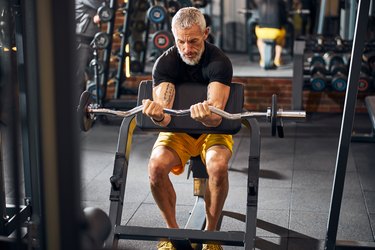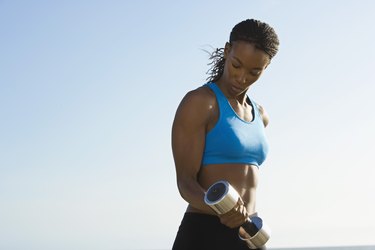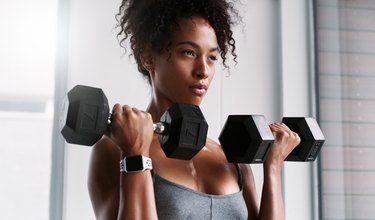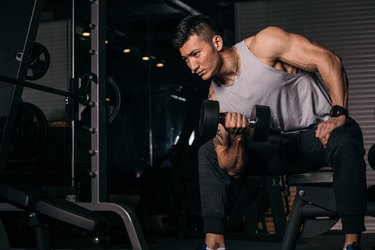

We're all for functional fitness, but many lifters will confess they want bigger biceps, and they love arm day.
Time to pray at the preacher bench — the angled bench used to isolate the upper arms is worshipped by everyone hoping for a ticket to the gun show. Here's everything you need to know to do preacher curls right.
Video of the Day
- What is a preacher curl? It's a biceps exercise that involves sitting at a preacher bench — a bench with a seat and a separate, angled pad used to immobilize the rest of the body. The move is done with your feet on the floor, and the pad in your armpits. In this position, you curl weight(s) toward your shoulders.
- What muscles does the preacher curl work? It builds the biceps brachii, brachialis and brachioradialis in your upper arm and forearms.
- Who can do this exercise? This move is safe for all exercisers who can perform it without pain.
How to Do Preacher Curls With Perfect Form
- Sit tall at a preacher curl bench with your knees bent and feet flat on the floor. The angled preacher pad should fit snugly under your armpit.
- Hold dumbbells at arm’s length with an underhand grip, palms facing up. Each upper arm should be in line with your forearm so that when your elbow is extended, your arm forms a straight line from your shoulder to your fingers.
- Keeping your palms facing up, bend your elbows to bring the dumbbells up towards your shoulders. Don’t go all the way up, though! Stop when your biceps is at peak contraction, around when your forearm is just about perpendicular to the floor. This will keep tension on the biceps instead of letting them go slack.
- Squeeze your biceps at the top.
- Control the weight as you lower back to the starting position, finishing with your elbow just slightly bent so you don’t overextend the joint.
Can You Do Preacher Curls at Home?
If you own a bench with a preacher curl pad, you can of course perform this move at home.
If you don’t, it’s still possible to make it happen. Some lifters perform single-arm curls with their upper arm against an incline bench to keep it still. Others use the back of a chair.
3 Preacher Curl Benefits
1. It Builds Bigger Arms
"Everyone should be doing this variation of the curl" if they want to grow their arms, says Brandon Lirio, an ISSA certified personal trainer, director of BattleGround Fitness and a PNBA professional bodybuilder.
That's because this biceps curl variation really zeroes in on the biceps brachii — the two-headed muscle that you think of as the "biceps" — as well as the nearby brachialis and the brachioradialis. These three muscles work to bend and unbend your elbow, and play different roles in twisting your forearm. The main preacher curl muscle worked is the biceps brachii.
2. It Doesn't Let You Cheat
This biceps move is great for people who usually "cheat" when doing curls.
The immobilization of the rest of the body by the preacher bench means you cannot swing your body or use your back to help curl the weight — it's all action, Lirio says.
3. It Strengthens Your Forearms
Do preacher curls work your forearms? Yes. The brachioradialis, one of the muscles in your forearm, gets a good workout with this exercise.
While the PC doesn't work the forearms quite as much as some other variations, you can increase how hard your forearms have to work by trying to crush the weights with your hands throughout each rep.
Are Preacher Curls as Good as Other Biceps Curl Variations?
In a 2014 study from the American Council on Exercise, researchers found that preacher curls (PCs) actually created less overall activation of the biceps brachii compared with some other curl variations when measured using an electromyography machine, or EMG.
This may be due to the angle that the bench creates: Instead of the being perpendicular to the floor, the upper arm is at about a 45-degree angle to the torso. This makes the PC more difficult at the start, but easier near the top of the move.
Just because it had less overall activation doesn’t mean the PC is worthless, or even that it’s “worse” than options like the concentration curl, which scored highest on activation. The difference in these activations was only a few percentage points overall. So if you like the PC, it will still work your biceps while performing an exercise you enjoy.
Also worth noting: Participants in the study performed all the curls with perfect form. So if you’re swinging on your biceps curls, as many lifters do, you may not be getting as much biceps activation as you would on a preacher bench.
For lifters who tend to cheat, the preacher can create a powerful training stimulus.
6 Preacher Curl Form Tips
1. Make Sure the Pad Is in Your Armpits
Adjust your seat so that you're able to sit up straight with the preacher pad in your armpits. This will keep the rest of your body from interfering with the curl, so you can't swing and cheat the movement.
2. Keep a Straight Line From Shoulders to Wrists
Unlike a mobile joint, like your hip or shoulder, which can move in lots of directions, your elbow is a stable, hinge-like joint that should move in only one way — raising and lowering your forearm toward and away from your upper arm.
Keeping your arm in a straight line during the PC reduces your likelihood that you'll accidentally twist the joint and cause injury.
3. Touch Your Biceps Before Each Set
Focusing your mind on the muscle you're trying to work can actually increase the recruitment and activity of that muscle, according to a March 2016 study in the European Journal of Applied Physiology.
To increase this mind-muscle connection, some athletes, like Andre Drapiza, a bodybuilder who placed 11th at the Amateur Mr. Olympia in Classic Physique, actually touch the muscle with their hand before each set.
Even if you don't tap your muscle with your finger, concentrate on the biceps to increase its activation.
4. Stop the Rep Before Your Biceps Do
Because of the angle of the preacher bench, you can actually curl the weight too high, Lirio says.
Once your lower arm becomes completely vertical, your biceps no longer have to work. So stop the lifting portion of each repetition just before your arms each vertical and your biceps starts to release.
5. Lower the Weight Slowly
Focusing on the lowering, or eccentric, portion of the exercise increases how long your muscles are under tension, or working. In fact, eccentric training is a major stimulus for muscle growth.
So don't just let your arm drop after you've curled the weight. Control it as you come back down.
6. Get a Full Stretch, but Don’t Hyper-Extend
PCs help keep you from cheating caused by swinging your body, but you can still cheat them in one way: by shortening the range of motion.
Because of the angle of the bench, PCs are much easier at the top than they are at the bottom. And that bottom portion is where you're most likely to cheat. Don't do it!
Go all the way down with each rep, but don't hyper-extend your elbow. Go until your elbow is straight but not locked out (or even a tiny bit bent) and then start your next rep.
3 Preacher Curl Variations
Move 1: Hammer-Grip Preacher Curl
When you perform curls with a "hammer grip," where your palms face each other, the exercise is generally easier. Conventional wisdom says that this is because the brachialis muscle helps the biceps brachii perform the lift, but that hasn't been proven in studies.
- Sit tall at a PC bench with your knees bent and feet flat on the floor. The angled preacher pad should fit snugly under your armpit.
- Hold dumbbells at arm’s length with a hammer grip, palms facing each other. Each upper arm should be in line with your forearm so that when your elbow is extended, your arm forms a straight line from your shoulder to your fingers.
- Keeping your palms facing each other, bend your elbows to bring the dumbbells up towards your shoulders. Don’t go all the way up, though! Stop when your biceps is at peak contraction, around when your forearm is perpendicular to the floor. This will keep tension on the biceps instead of letting them go slack.
- Squeeze the biceps at the top.
- Control the weight as you lower back to the starting position, finishing with your elbows just slightly bent so you don’t overextend the joint.
Move 2: EZ-Bar Preacher Curl
Performing PCs with the EZ-bar is, as the bar's name suggests, easier. Just be careful that your stronger arm isn't doing all the work, Lirio says.
While this can feel easier than using dumbbells, a July 2018 study in PeerJ found that doing curls with an EZ-bar actually works the muscles to a higher degree than dumbbells.
- Sit tall at a PC bench with your knees bent and feet flat on the floor. The angled preacher pad should fit snugly under your armpit.
- Hold the EZ-bar at arm’s length with an underhand grip, palms facing up. Each upper arm should be in line with your forearm so that when your elbow is extended, your arm forms a straight line from your shoulder to your fingers.
- Bend your elbows to bring the bar up towards your shoulders. Don’t go all the way up, though! Stop when your biceps is at peak contraction, around when your forearm is perpendicular to the floor. This will keep tension on the biceps instead of letting them go slack.
- Squeeze the biceps at the top.
- Control the weight as you lower back to the starting position, finishing with your elbows just slightly bent so you don’t overextend the joint.
Move 3: Resistance-Band Preacher Curl
With resistance bands, the resistance actually increases as your arms get higher and the band becomes more taut. Some lifters will combine weights with resistance bands (or chains) to create "accommodating resistance." In this case, the weights make the curl hard at the start, and the resistance band makes the end of the move more difficult.
You can also just use the band itself. Wrap the band under the legs of the preacher bench, or if it can't be moved, put it under your feet on the floor.
- Sit tall at a PC bench with your knees bent and feet flat on the floor. The angled preacher pad should fit snugly under your armpit. Wrap a resistance band under the feet of the bench or under your feet so you can grab it with both hands using an underhand grip.
- Hold the band at arm’s length with an underhand grip, palms facing up. Each upper arm should be in line with your forearm so that when your elbow is extended, your arm forms a straight line from your shoulder to your fingers.
- Keeping your palms facing up, bend your elbows to bring the band up towards your shoulders. Don’t go all the way up, though! Stop when your biceps is at peak contraction, around when your forearm is perpendicular to the floor. This will keep tension on the biceps instead of letting them go slack.
- Squeeze the biceps at the top.
- Control the band as you lower back to the starting position, finishing with your elbows just slightly bent so you don’t overextend the joint.
Does Your Gym Have a Preacher Curl Machine?
Many gyms have fixed biceps curl machines. These can be helpful in learning the movement, but it's important to remember that machines, while adjustable, are never going to fit everyone's body perfectly. If you have any elbow or shoulder discomfort, switch to using a regular preacher curl stand with a free weight.
FYI, cable machine preacher curls are another popular machine variation. You do these with a bench or on the floor with kneeling preacher curls.
More Biceps Curl Variations
- American Council on Exericse: "ACE Study Reveals Best Biceps Exercises"
- Journal of Applied Physiology: "Importance of mind-muscle connection during progressive resistance training"
- PeerJ: "Differences in electromyographic activity of biceps brachii and brachioradialis while performing three variants of curl"



